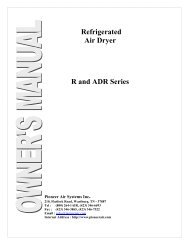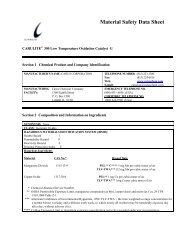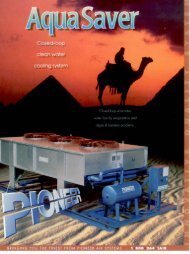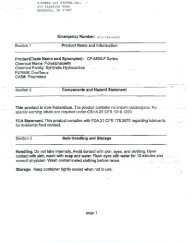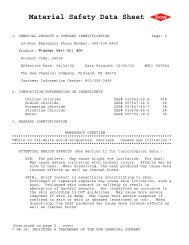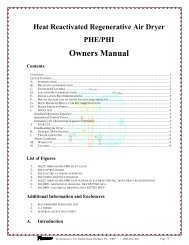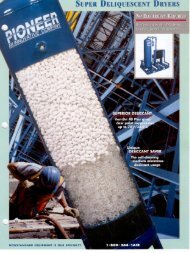XDT Manual - Pioneer Air Systems Engineering
XDT Manual - Pioneer Air Systems Engineering
XDT Manual - Pioneer Air Systems Engineering
You also want an ePaper? Increase the reach of your titles
YUMPU automatically turns print PDFs into web optimized ePapers that Google loves.
<strong>XDT</strong> User’s <strong>Manual</strong>high end of Analog Output Lock/Unlock the instrument Sensor Cable Compensation(back to) .These eleven functions are explained in their respective sections which follow. Note that modes6,7,8&9 will appear only on instruments with the analog output option. Changes can be madeonly to an unlocked instrument, the changes are stored (when the MODE button is pressed) andretained even if the instrument power is turned off.1. Display of alternate units: In this mode, a second engineering unit can be chosen to be displayedalternating with the engineering unit selected in the operating state, for example, adewpoint can be alternately shown in °C and in PPM.CAUTION:2), 3), 4) and 5) are set at the factory and need only be modified when a sensor is changed.2. Selecting the sensor type: In this mode the user can select the software matching the type ofsensor installed in the instrument:XT1 : XTR-100 (-100°C to +20°C);XT6 : XTR-65 (-65°C to +20°C);DB : show impedance of any sensor, disableOpen and Short error massages.3&4Adjusting low end sensor attenuation and dewpoint: These modes are used to enter a datapair representing a low dewpoint and the sensor attenuation measured at this low dewpoint.(see Sensor Theory of Operation appendix F). This data pair should not be modified unless thesensor is replaced (refer to procedures for replacing a sensor in appendix L). The sensor shippingcontainer is labeled with the proper values.5. Calibration Adjustment: In this mode the user can enter a sensor specific Adjustment Valueto improve the instruments’ accuracy in the range of -50°C to -10°C, this adjustment has verylittle or no effect outside this range. The Calibration Adjustment Value is printed on the shippingcontainer supplied with the sensor, or may be derived if the sensor can be exposed to aknown reference.Deriving an Adjustment Value: If the adjustment value for your sensor is not known, contactyour representative and follow the instructions below for entering known values. If the valueis not available, then it may be derived using a manual method, provided that a moisture calibrationfacility is available.The calibration must be done in the range of -25°C to -20°C (attempting to calibrate outsidethis range may cause inaccuracies), the dewpoint must be kept stable during calibration and itmust be measured accurately by a reference instrument such as a chilled mirror. One must alsonote the state of pressure compensation and turn it on or off as applicable to the reference.The necessary steps are described below (also refer to the Set-Up State flow diagram inAppendix B):a. Make sure that the low attenuation and low dewpoint are correctly entered for this sensor.b. SpanCheck the sensor.c. Dry-down the sensor for at least 12 hrs.d. Expose the sensor to the known dewpoint (-25°C to -20°C), for a sufficient time (at least 30min.)e. Go to the CAL/ADJ mode and press the UP button, the display will show the current value,in the range of -2.50 to +2.50 followed by blinking horizontal lines.f. Observe the display, if the buttons are not being pressed; the display will every few secondsshow for a short duration the dewpoint as being computed at the moment (utilizing the current26



